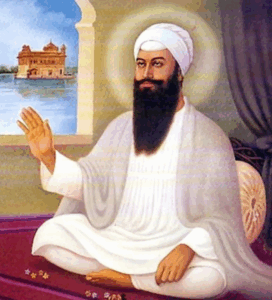 Guru Angad Dev Ji, originally named Lehna, was born on March 31, 1504, in the village of Matte-di-Sarai (now known as Sarainaga, in Punjab, India). His father, Bhai Pheru Mal Ji, was a Hindu trader and a devout Vaishnavite. From a young age, Lehna showed deep religious devotion and often participated in spiritual activities. He grew up with a strong belief in Hindu deities and became a priest of the goddess Durga. Despite this, his heart yearned for a deeper spiritual understanding beyond ritualism and idolatry.
Guru Angad Dev Ji, originally named Lehna, was born on March 31, 1504, in the village of Matte-di-Sarai (now known as Sarainaga, in Punjab, India). His father, Bhai Pheru Mal Ji, was a Hindu trader and a devout Vaishnavite. From a young age, Lehna showed deep religious devotion and often participated in spiritual activities. He grew up with a strong belief in Hindu deities and became a priest of the goddess Durga. Despite this, his heart yearned for a deeper spiritual understanding beyond ritualism and idolatry.
The turning point in Lehna’s life came when he heard the divine hymns of Guru Nanak Dev Ji being sung in a village near Khurana, where he had settled after marriage. He was deeply moved by the words and desired to meet the Guru. In 1532, he traveled to Kartarpur, where Guru Nanak was living. The moment he met Guru Nanak Dev Ji, Lehna was spiritually transformed. He renounced his former beliefs and became a dedicated disciple. He served Guru Nanak with the utmost humility, devotion, and obedience — cleaning the Guru’s utensils, serving in the langar (community kitchen), and participating in all forms of seva (selfless service).
Lehna’s humility was constantly tested by Guru Nanak, who wanted to find a successor who truly embodied Sikh values. While other followers hesitated in moments of difficulty or ego, Lehna never questioned the Guru’s will. His complete surrender and devotion led Guru Nanak Dev Ji to declare him as the next Guru. In 1539, Guru Nanak blessed him with the title of “Angad”, meaning “of my own limb” — symbolizing that Lehna had become an extension of Nanak himself. Guru Nanak passed the light of Guruship to Angad before merging with the Eternal.
As the second Guru, Guru Angad Dev Ji played a vital role in shaping the Sikh faith. One of his most significant contributions was the standardization and promotion of the Gurmukhi script, which he developed based on the ancient Landa script. This became the script for recording Sikh scriptures, including the hymns of Guru Nanak and future Gurus. By doing this, he helped make the spiritual teachings accessible to the common people, in their own language, rather than in Sanskrit or Persian, which were mostly limited to scholars and priests.
Guru Angad Dev Ji also gave great importance to physical health and education. He promoted wrestling and sports as a means of maintaining a strong body and mind. He encouraged schools where children could learn Gurmukhi and also emphasized the moral and spiritual upbringing of the youth. Like Guru Nanak, he continued the practice of Langar, ensuring the Sikh community remained centered around equality, service, and humility.
Guru Angad Dev Ji lived a life of simplicity, service, and devotion. He led the Sikh community from 1539 until 1552, during a time of great social and religious division. He remained focused on spreading the message of Naam (God’s Name), Seva (selfless service), and Sangat (holy congregation). Before his passing on March 29, 1552, in the town of Khadur Sahib, he chose Amar Das Ji, a dedicated follower, to be the third Guru of the Sikhs. Guru Angad Dev Ji’s leadership solidified the foundations laid by Guru Nanak and ensured that the spiritual light of Sikhism would continue to shine through generations.


Leave a Reply